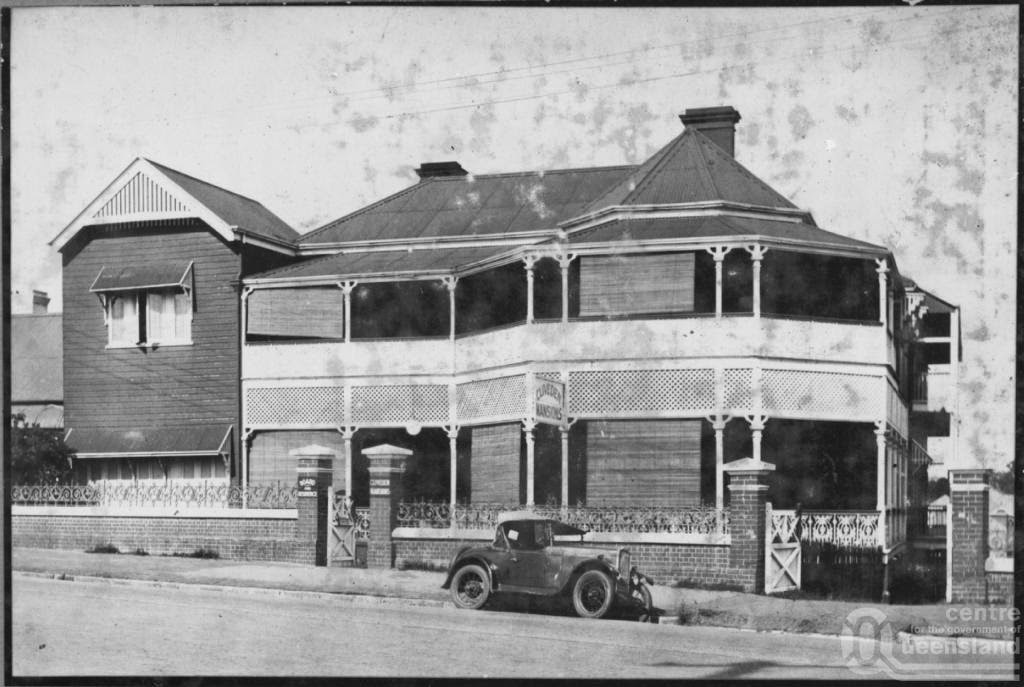The history of this humble boarding house in Spring Hill concerns two widows - one who built the house as her residence, and one who, out of necessity, converted the property into a boarding house. This is a current photograph.
![]()
Pauline Eschenhagen was the widow of Karl Ernst Eschenhagen (known as Ernst), a baker originally from Crossen/Oder, Germany, who established one of Brisbane's best hospitality businesses in the late 19th century. It is said that Eschenhagen begged Morrow"s Biscuit Factory for a bag of sugar and a bag of flour to start his George St bakery that subsequently spawned branches in Edward St and Fortitude Valley and then a Queen St restaurant that could seat almost 500 diners. Ernst Eschenhagen was a celebrated baker, restaurateur and caterer who could boast that some of Brisbane's elite citizens, including successive governors of Queensland, were his customers. Here is a picture of his staff at a picnic in 1898.

(Photo: © 2014 the foto fanatic)
The building is now called Cliveden Mansions and it is included on the Queensland Heritage Register. The original house erected here was named Chippendale and it was built circa 1889 for Mrs Selina Forth who moved in in 1890. Prior to that Mrs Forth was resident at Stanley Hall, Clayfield; a magnificent house previously seen in these pages. Unfortunately both Mrs Forth's 20 year-old daughter Clara, and her husband John Forth, a prominent produce agent in Brisbane, died within the family's first couple of years at Stanley Hall, prompting Mrs Forth's move into Spring Hill.
Mrs Forth passed away in 1911 and in 1913 the property was sold to Mrs Pauline Eschenhagen, a well-known restaurateur and caterer. The Eschenhagen family owned Chippendale until 1949, although they changed the name of the property to Cliveden Mansions in 1941. The following photograph shows the house around that time.
(Photographic collection, Queensland State Archives)Pauline Eschenhagen was the widow of Karl Ernst Eschenhagen (known as Ernst), a baker originally from Crossen/Oder, Germany, who established one of Brisbane's best hospitality businesses in the late 19th century. It is said that Eschenhagen begged Morrow"s Biscuit Factory for a bag of sugar and a bag of flour to start his George St bakery that subsequently spawned branches in Edward St and Fortitude Valley and then a Queen St restaurant that could seat almost 500 diners. Ernst Eschenhagen was a celebrated baker, restaurateur and caterer who could boast that some of Brisbane's elite citizens, including successive governors of Queensland, were his customers. Here is a picture of his staff at a picnic in 1898.
(Photo: State Library of Queensland and John Oxley Library; #183931)
Things turned nasty for the Eschenhagens though. As a result of Australia's involvement in the Boer War anti-German sentiment run rampant, leading to a boycott of the Eschenhagen business. Judge William Shand wrote "before the war no more a popular and prosperous caterer was to be found in Brisbane... But his shop is a desert and picnics and jaunterings know him no more."
The business slowly recovered after the Boer War, but Ernst Eschenhagen took his own life in 1906. His sister-in-law, Pauline's younger sister Berthe, put that down to "too much debt, from too much wine and women", but who knows what part was played by the hatred endured during the war years.
Pauline Eschenhagen continued to run the business with the help of her son Karl (Charles). But the prospect of a second round of racial bigotry during WWI was too much - she sold the business in 1915 and used the proceeds to hire the original architect of Chippendale, GHM Addison, to design a large extension that allowed the property to be leased out as a boarding house.
Cliveden Mansions continues in use as a boarding house today.
Reference:"The Eschenhagens: Saga of a Celebrated Family", HJ Summers
"Berthe's Story: Tales of a Grandmother", Doreen Wendt-Weir via asslh.org.au
Click here for a Google Map.
tff

